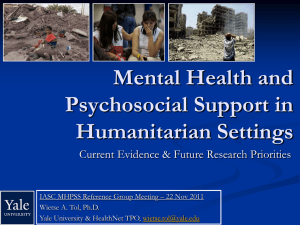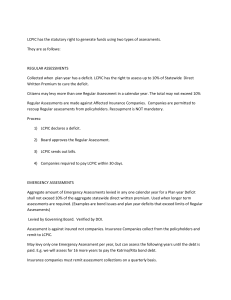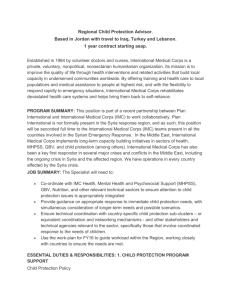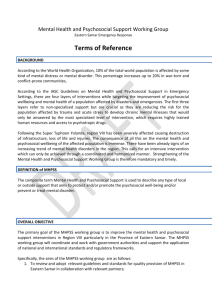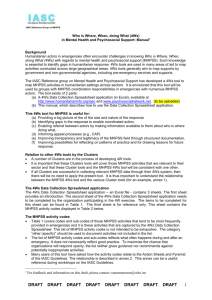IASC Mental Health and Psychosocial Support Assessment Guide
advertisement
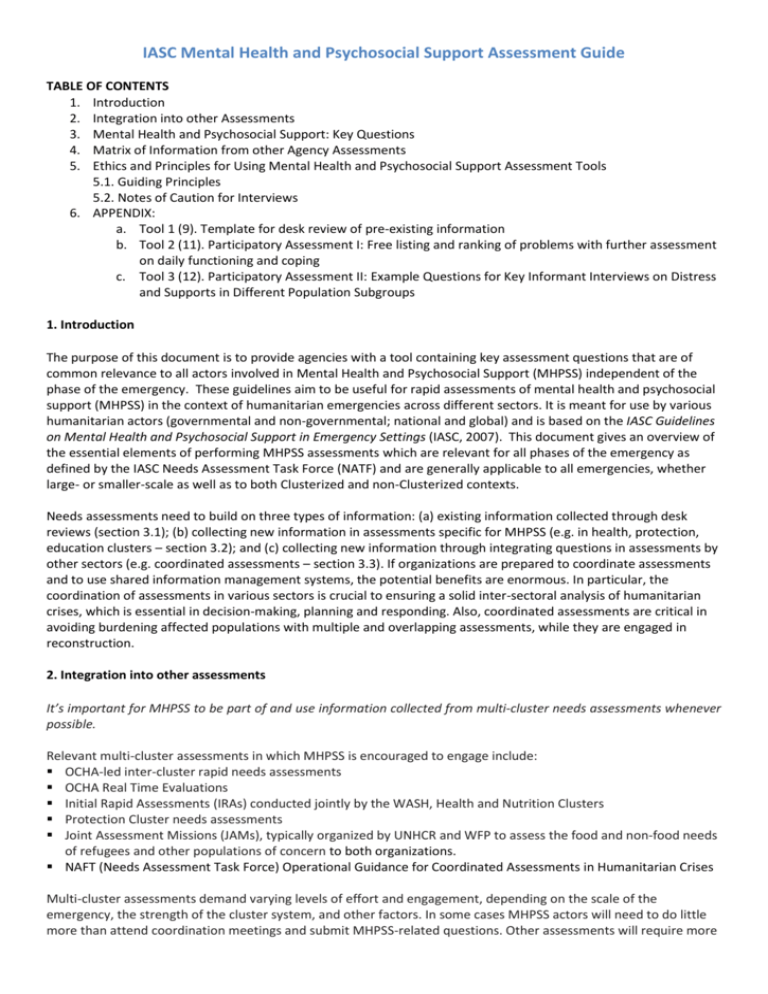
IASC Mental Health and Psychosocial Support Assessment Guide TABLE OF CONTENTS 1. Introduction 2. Integration into other Assessments 3. Mental Health and Psychosocial Support: Key Questions 4. Matrix of Information from other Agency Assessments 5. Ethics and Principles for Using Mental Health and Psychosocial Support Assessment Tools 5.1. Guiding Principles 5.2. Notes of Caution for Interviews 6. APPENDIX: a. Tool 1 (9). Template for desk review of pre-existing information b. Tool 2 (11). Participatory Assessment I: Free listing and ranking of problems with further assessment on daily functioning and coping c. Tool 3 (12). Participatory Assessment II: Example Questions for Key Informant Interviews on Distress and Supports in Different Population Subgroups 1. Introduction The purpose of this document is to provide agencies with a tool containing key assessment questions that are of common relevance to all actors involved in Mental Health and Psychosocial Support (MHPSS) independent of the phase of the emergency. These guidelines aim to be useful for rapid assessments of mental health and psychosocial support (MHPSS) in the context of humanitarian emergencies across different sectors. It is meant for use by various humanitarian actors (governmental and non-governmental; national and global) and is based on the IASC Guidelines on Mental Health and Psychosocial Support in Emergency Settings (IASC, 2007). This document gives an overview of the essential elements of performing MHPSS assessments which are relevant for all phases of the emergency as defined by the IASC Needs Assessment Task Force (NATF) and are generally applicable to all emergencies, whether large- or smaller-scale as well as to both Clusterized and non-Clusterized contexts. Needs assessments need to build on three types of information: (a) existing information collected through desk reviews (section 3.1); (b) collecting new information in assessments specific for MHPSS (e.g. in health, protection, education clusters – section 3.2); and (c) collecting new information through integrating questions in assessments by other sectors (e.g. coordinated assessments – section 3.3). If organizations are prepared to coordinate assessments and to use shared information management systems, the potential benefits are enormous. In particular, the coordination of assessments in various sectors is crucial to ensuring a solid inter-sectoral analysis of humanitarian crises, which is essential in decision-making, planning and responding. Also, coordinated assessments are critical in avoiding burdening affected populations with multiple and overlapping assessments, while they are engaged in reconstruction. 2. Integration into other assessments It’s important for MHPSS to be part of and use information collected from multi-cluster needs assessments whenever possible. Relevant multi-cluster assessments in which MHPSS is encouraged to engage include: OCHA-led inter-cluster rapid needs assessments OCHA Real Time Evaluations Initial Rapid Assessments (IRAs) conducted jointly by the WASH, Health and Nutrition Clusters Protection Cluster needs assessments Joint Assessment Missions (JAMs), typically organized by UNHCR and WFP to assess the food and non-food needs of refugees and other populations of concern to both organizations. NAFT (Needs Assessment Task Force) Operational Guidance for Coordinated Assessments in Humanitarian Crises Multi-cluster assessments demand varying levels of effort and engagement, depending on the scale of the emergency, the strength of the cluster system, and other factors. In some cases MHPSS actors will need to do little more than attend coordination meetings and submit MHPSS-related questions. Other assessments will require more detailed planning and coordination, and/or contributing staff and resources such as data collectors and transport. Information obtained from this assessment guide can be included and written up as part of other assessments. Despite positive moves towards more coordinated assessments in emergencies, it cannot be assumed that MHPSS will automatically be included in multi-cluster assessments. MHPSS Coordinators may need to be proactive in order to find out what assessments are planned and advocate for MHPSS to be included. Examples of indicators relevant for MHPSS are provided in section 3.3. 3. Mental Health and Psychosocial Support: Key Questions The following are suggested key questions for the assessment of mental health and psychosocial support aspects in humanitarian emergencies. These questions are meant to be cross-cutting and can be used by different agencies. Questions also require different methodologies and are aimed at different types of respondents and key informants. Questions should be chosen by agencies depending on the context and relevance for specific program planning. It should therefore be noted that no single agency would be expected to cover all of the questions. 3.1.) Desk Top Review of Pre-Existing Information The desk top review of existing literature and program documents is aimed at gathering and summarizing existing information, in order to focus assessments, make the best use of available resources, and avoid overburdening people by asking information that was already available. The desk top review covers what information is available on the socio-cultural context, mental health and psychosocial context (e.g. prevalence and expression of mental health problems, mental health resources, systems and policies) and humanitarian context (see APPENDIX for detailed template). 3.2.) Collecting new information in MHPSS assessments Component Questions Methods 1 1. Relevant contextual information Culture-specific beliefs and practices What are the essential concerns, beliefs, and cultural issues that aid agencies should be aware of when providing mental health and psychosocial support for [target group]? What actions should be avoided? Practices around death and mourning When someone in this community dies how do the family and friends express their grief? What are the first things to be done? Why? How do other family/ friends/ community members express support? What happens to the body? What other things need to be done? How long does mourning continue? What happens if the body cannot be found/ identified? What happens if the process you described (e.g., burial) cannot be done? Do you have people with severe mental disorders in the community? May I ask about them? What kind of problems do they have? In general, what do community members think about people with severe mental disorders? How do they treat them? What do community members normally do to deal with people with severe mental disorders? Attitudes toward severe mental disorder Interview with: (a) cultural/medical/ social anthropologist/ sociologist/ other socio-cultural expert, (b) key informant Source: Tool 9 (part B) Key informant or group interview with community members who have in-depth knowledge of the affected community. Source: Tool 12. (C. Nature of distress and support, C4) Key informant or group interview with community members who have in-depth knowledge of the affected community. Source: Tool 12. (C. Nature of Distress and Support, C5) 1 Main headings correspond to those in the IASC (2007) Guidelines on Mental Health and Psychosocial Support in Emergency Settings, section 2 Assessment, monitoring and evaluation; 2.1 Conduct assessments of mental health and psychosocial issues 2. Experience of the emergency Experience of the emergency (perceived causes and expected consequences) What do people in your community believe has caused the current [NAME OF HUMANITARIAN CRISIS]? According to community members, what are or will be the further consequences of the [NAME OF HUMANITARIAN CRISIS]? How has the [NAME OF HUMANITARIAN CRISIS] affected daily community life? How has [NAME OF HUMANITARIAN CRISIS] affected people’s livelihood activities/ work? How are people trying to rebuild and recover from this crisis? 3. Mental health and psychosocial problems Key informant or group interview with community members who have in-depth knowledge of the affected community. Source: Tool 12. (A. Sources of distress) Culture-specific expressions of distress How would I as an outsider recognize a child/a woman/a man/someone who is bereaved who is emotionally upset/ distressed by [NAME OF HUMANITARIAN CRISIS]? a. What does the [person] look like? b. How do they behave? c. Are there different types of being upset? What are they? d. How can I distinguish between [NAME ANSWER FROM ABOVE]? What kind of problems do _____ [GROUP OF INTEREST]2 have because of the humanitarian situation? Please list as many problems that you can think of. Select those problems which are especially relevant from a mental health perspective (problems related to social relationships, feelings, thinking, behaviour “You mentioned a number of problems, including [READ OUT PROBLEMS NAMED ABOVE] Of these problems, which is the most important problem?” “Why?” “Of these problems, which is the second most important problem?” “Why?” “Of these problems, which is the third most important problem?” “Why?” Key informant or group interview with community members who have in-depth knowledge of the affected community. Source: Tool 12. (C. Nature of distress and support, C1-C4) If a [INSERT GROUP OF INTEREST] suffers from [NAME A MENTAL HEALTH RELATED PROBLEM], what kind of tasks will be difficult for them? For exampletasks/things they do for themselves, their family or in their community. REPEAT FOR EACH PROBLEM MENTIONED PREVIOUSLY 4. Existing sources of psychosocial well-being and mental health Coping methods What kind of things do _____ [INSERT GROUP OF INTEREST] people do to deal with such problems? E.g. by themselves, with their families, or their communities? Would doing that help with the problem? REPEAT FOR EACH PROBLEM MENTIONED PREVIOUSLY Community What do community members normally do to reduce sources of the upset/ distress of children/men/women or someone support and who is bereaved/people with severe mental resources disorders/survivors of violence/people who have Free List (individuals; general community members living in the humanitarian setting) Source: Tool 11 (2. Impairment of daily activities) Priority Mental Health Related Problems Impairment of daily activities 2 Groups of interest may be men, women, youth (girls, boys), the elderly, etc Free List and ranking (individuals; general community members living in the humanitarian setting) Source: Tool 11 (1.1. General problems, 1.2. List of mental health related problems, 1.3. Three most important problems.) Free List (individuals; general community members living in the humanitarian setting) Source: Tool 11 (3. Coping methods, 3.1.) Key informant or group interview with community members who have in-depth knowledge of the affected community. problems with alcohol? What are community members doing right now to reduce upset/ distress of [target group]? What else is being done right now to help [target group]? Where do [target group] seek help? What more could be done to help [target group]? Source: Tool 12. (C. Nature of distress and support, C1-C7) 3.3 MHPSS information collected through coordinated assessments in other sectors Indicators relevant to MHPSS that have been published by the Needs Assessment Task Force in its the Operational Guidance for Coordinated Assessments in Humanitarian Crises (IASC, 2011) and others are displayed below. While this is neither a perfect nor a full set of indicators, it is important to note that these are examples of indicators that may be collected by clusters/sectors and that these are good additional data sources for MHPSS assessment, monitoring and evaluation. Sources: IASC (2011). NATF Operational Guidance on Coordinated Assessments Available at: http://oneresponse.info/resources/NeedsAssessment/publicdocuments/Operational%20Guidance%20for%20 Endorsement%20-%20%20Final%20Version.pdf Inter-Agency Standing Committee (IASC). Health, Nutrition & WASH Clusters, Initial Rapid Assessment (IRA): Field Assessment Form and Data Entry Tool. The Sphere Project (2011). Humanitarian Charter and Minimum Standards in Humanitarian Response. Available at: www.sphereproject.org Sector Top Level Outcome Camp Management Source NATF Shelter Health NATF NATF Sphere NATF IRA Education NATF MHPSS Related Information and Indicators Covered % of population in worst quintile of functioning , including those with severe or extreme difficulties in functioning % of IDP camps that have a dispute resolution mechanism % of IDP camps in which people are able to move freely inside and outside the camp % of IDP camps where programs for disabled persons are offered to camp residents % of IDP camps where programs for single heads of households are offered to camp residents % of IDP camps where programs for older persons are offered to camp residents % of IDP camps where programs for children are offered to camp residents % of affected population with a covered living area of less than 3.5 m2 per person Number of cases or incidence rates for selected diseases relevant to the local context, 2.Essential health services, 2.3. Essential health services – sexual and reproductive health, Essential health services – sexual and reproductive health standard 1: Reproductive health, Key Indicators:” Ensure services for clinical management of sexual violence, including access ••to mental health and psychosocial support and legal assistance (see guidance note 3 and Protection Principle 2, guidance note 7 on page 37). 2.5.Essential health services – mental health, Essential health services – mental health standard 1: Mental health, Key Indicator: All health facilities have trained staff and systems for the management of ••mental health problems. 2.6. Essential health services – non-communicable diseases, Key Indicators: All primary healthcare facilities have clear standard operating procedures for referrals of patients with NCDs to secondary and tertiary care facilities. All primary healthcare facilities have adequate medication for continuation of treatment to individuals with NCDs who were receiving treatment before the emergency. 5.2 Health profile: 5.2.8 Have there been reports of HAZARDOUS SUBSTANCE USE (e.g. injecting drugs, heavy alcohol use)? 5.4 What are the priorities expressed by the population concerning health? 6.3 Checklist of Health Services Available: C. Community care, C8 (NCDs and Mental Health: Promote self-care, provide basic health care and psychosocial support, identify and refer severe cases for treatment, provide needed follow-up to people discharged by facility-based health and social services for people with chronic health conditions, disabilities and mental health problems) P: Primary Care, P8 (NCDs and Mental Health: P84-Mental health care: support of acute distress and anxiety, front line management of severe and common mental disorders) S. Secondary and Tertiary Care (NCDs and Mental Health: S82-Outpatient psychiatric care and psychological counselling, S83-Acute psychiatric inpatient unit) % of schools/learning spaces with life skill-based education on crisis-related issues % of schools/learning spaces offering psychosocial support for (a) children and youth; (b) teachers; Protection NATF Nutrition and Food Security Sphere % of surveyed sites with communal facilities with separate toilet and bathing facilities for males and Females Number of children in institutional care % of children with safe access to community spaces for socializing, play, learning % of surveyed sites where there is a functioning dispute resolution mechanism (judicial or customary/informal) to address housing, land and property grievances % of the affected population lacking personal identity documents % of surveyed sites where there is a functioning dispute resolution mechanism (judicial or customary/informal) to address housing, land and property grievances 4. Food Security 4.1. Food security – food transfers. Food security – food transfers standard 6: Food use, Key Indicators: Full presence of carers for all individuals with special assistance needs (see guidance note 5) [note from guidance note 5: “Outreach programmes or additional support and follow-up may be necessary to support some people with reduced capacity to provide food to dependents (e.g. parents with mental illness)”]. 4. Ethics and Principles for Using Mental Health and Psychosocial Support Assessment Tools 4.1. Guiding Principles Participation of relevant stakeholders (including governments, NGO’s, community and religious organizations, local research and university capacities, and affected populations) in design, implementation, interpretation of results, and translation of results into recommendations Inclusiveness of different sections of the affected population, including attention to children, youth, women, men, older persons, people with mental health problems, people with disabilities and different cultural, religious, and socio-economic groups. Relevant data collection with a focus on action, rather than purely collecting information. Collecting too much data (i.e. so much data that not all can be analyzed) or data that is unlikely to guide or translate into action is a waste of resources. Psychiatric epidemiological surveys - assessing the prevalence, distribution and correlates of mental disorders - can be of academic and advocacy value, but are outside the scope of the IASC MHPSS Guidelines and the current document. Attention to conflict, including maintaining impartiality, independence, and being considerate of possible tensions and power structures. Protection of people and groups providing data by taking into consideration protection threats and putting people at risk by asking questions, or inappropriately storing and/ or sharing data. Cultural appropriateness of assessment methodology, terminology and the behaviour and attitudes of assessment team members. Ethical principles, including respecting privacy, confidentiality, voluntary participation, informed consent, and the best interest of the interviewee. Assessors should take care to avoid raising expectations and make sure that assessments are linked to action and tangible benefits where possible. Assessment teams trained in ethical principles, possessing basic interviewing skills, knowledgeable about the local context, and balanced in terms of gender. Some of the team members should be themselves members of (or intimately familiar with) the local context. Data collection methods should adopt multi-method approaches including review of relevant literature, agency reports and policy documents, qualitative and quantitative data collection methods (e.g. key informant interviews, focus group discussions, surveys), observation, and site visits. Dynamism and timeliness. The guidelines describe assessment as a dynamic phased process. Assessments can take place in phases, with more detailed assessment taking place in later phases 4.2. Notes of Caution for Interviews a) Choose questions selectively. Do not use all questions from this tool. Assessors should choose those questions that are of relevance to them. b) Avoid lengthy interviews. Remember that a common mistake in assessments is to ask too many questions that are not subsequently analyzed, reported or otherwise used. Thus, do not ask more questions than needed. Interview length should be no more than 1 hour. If interview takes more than 1 hour, then it is advised to make a second appointment at another time for a follow-up interview. c) Be careful. Highly sensitive questions that may lead to bringing people (interviewee, interviewer, or other people) in danger should not be asked. Questions that are not very sensitive can be asked during group interviews, while, depending on the context, sensitive questions may be asked during individual key informant interviews. d) Adapt to your setting. Questions may be adapted for use in a group or individual setting. e) Use probes only when necessary. Questions 1 and 2 contain probes; these should be only asked if necessary (i.e. when the respondent cannot think of a response after some time). It is not necessary to use each probe one-by-one; they are meant as examples to stimulate a more elaborate response. Note that a suggested introduction for interviews can be found in the WHO MHPSS Toolkit [full reference to be added when available] Relevant Resources Allden, K., Jones, L., Weissbecker, I., Wessells, M., Bolton, P., Betancourt, T. S., et al. (2009). Mental health and psychosocial support in crisis and conflict: Report of the Mental Health Working Group—Humanitarian Action Summit 2009. Prehospital Disaster Medicine, 24(4), s217-s227. IASC (Feb 2011) NATF Operational Guidance on Coordinated Assessments, Available at: http://oneresponse.info/resources/NeedsAssessment/publicdocuments/Operational%20Guidance%20for%20E ndorsement%20-%20%20Final%20Version.pdf Wessels, M.G. (2009). Do No Harm: Toward Contextually Appropriate Psychosocial Support in Emergency Settings. American Psychologist, Nov. 2009, 842-851. APPENDIX [to be added when templates final] a. Tool 1 (9). Template for desk review of pre-existing information b. Tool 2 (11). Participatory Assessment I: Free listing and ranking of problems with further assessment on daily functioning and coping c. Tool 3 (12). Participatory Assessment II: Example Questions for Key Informant Interviews on Distress and Supports in Different Population Subgroups
